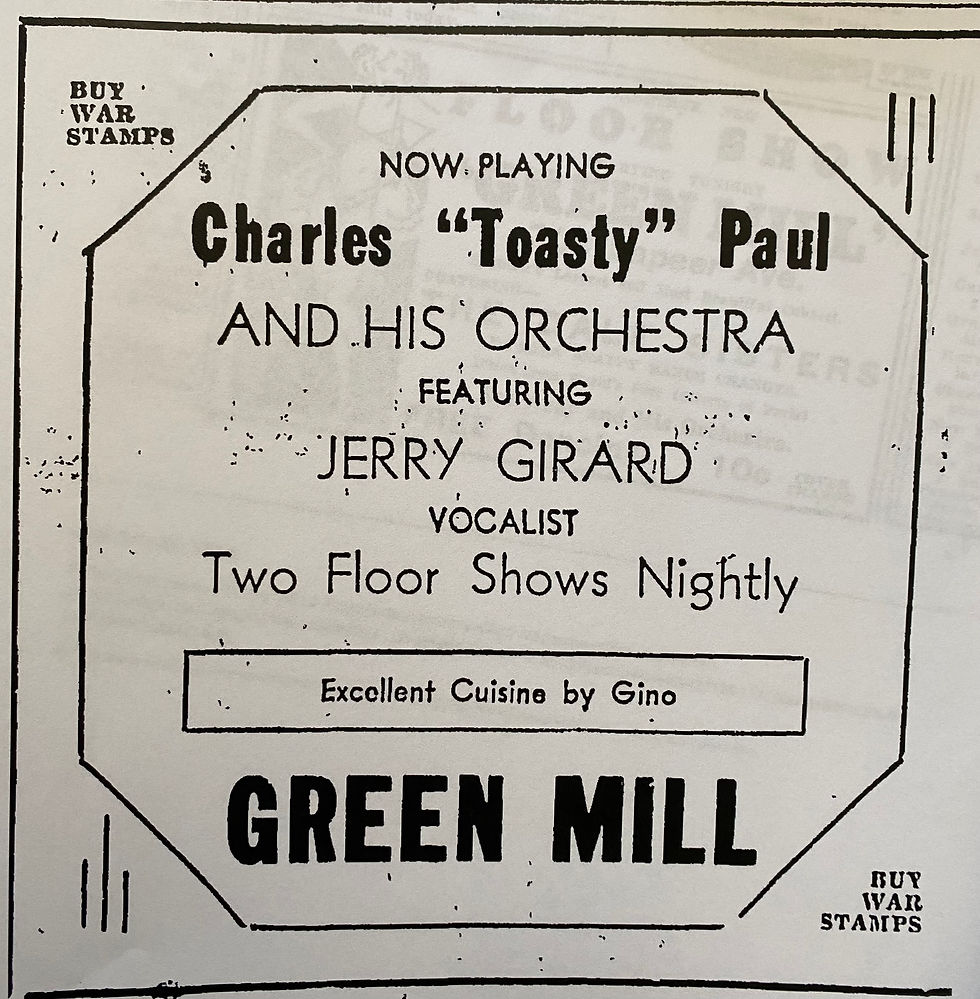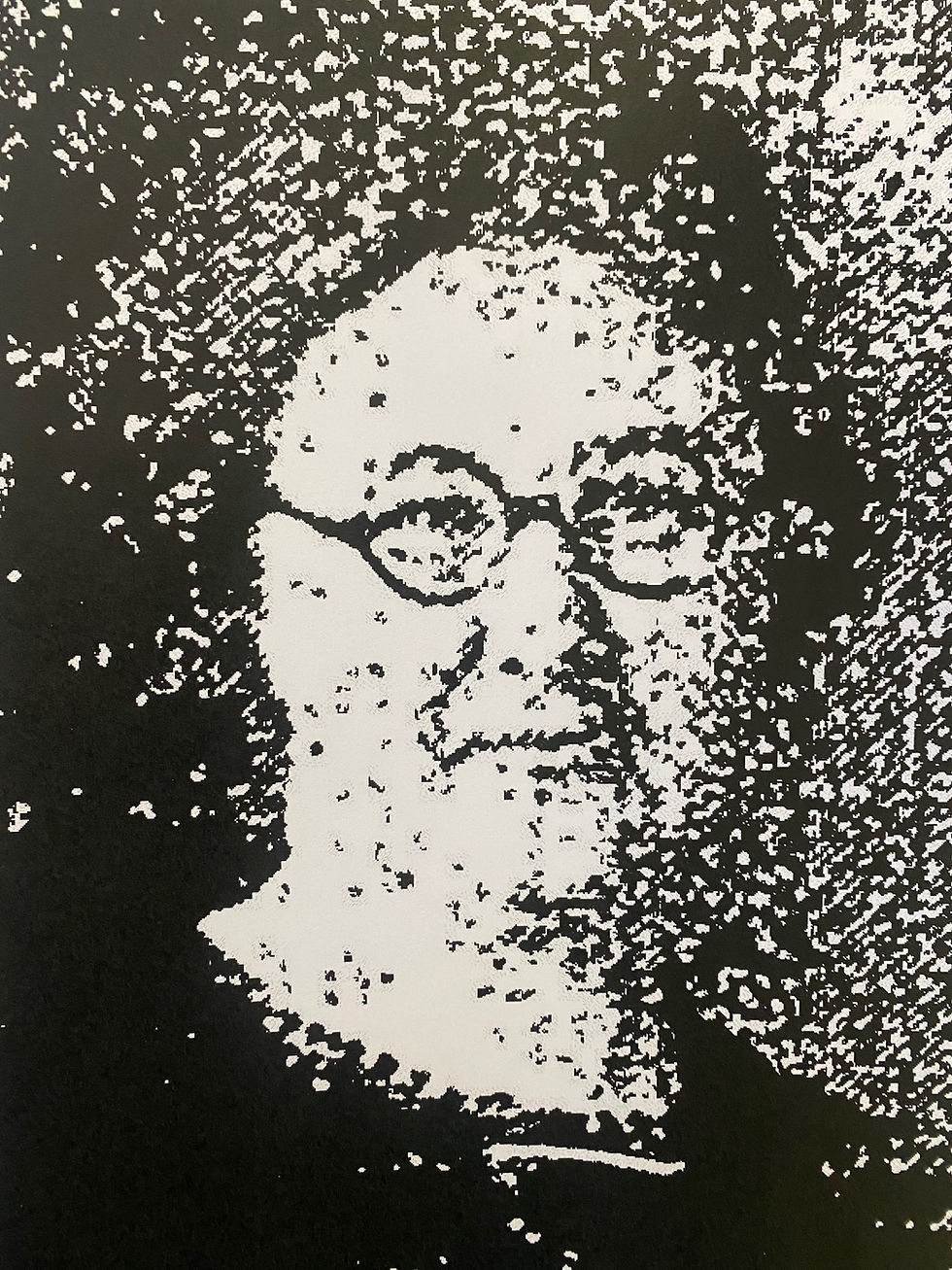Castle Cocktail Lounge: The Green Mill & The Suffering Bastard
- kellison71
- Jul 9, 2023
- 6 min read
“The Building at 309 [709] Lapeer avenue recently used as an automobile laundry is being remodeled and redecorated to serve as a huge ballroom, Art Noey, promotion manager, announced yesterday. It will be operated by the Saginaw Amusement company and will involve the employment of 24 persons. Formal opening of the place is scheduled for Saturday.”
-The Saginaw Sunday News, October 8, 1933.

Although only a few months earlier, the building had housed an auto laundry, when it opened during the depression, the Green Mill billed itself as “Saginaw’s largest and most beautiful cabaret.”
One could imagine such a business having extraordinary bartenders and free-flowing cocktails. Before we get into the Green Mill's building history, let's step back and learn about another remarkable bartender and his drink of choice.
Joe Scialon and the Suffering Bastard
Joe Scialon invented the original Suffering Bastard cocktail while bartending in Cairo, Egypt during World War II. While slinging drinks at the Shepheard Hotel, he crafted this “hangover cure” that was especially popular with the British troops under the command of Field Marshal Bernard Montgomery.

Joe was the kind of bartender that knew everyone and could talk with anyone. He was fluent in English, French, Italian, Greek, Arabic, German, and Russian! He was comfortable hosting dignitaries and common folk alike. Most just knew him as Joe the bartender. He thought of his bar as a parish and himself as a healer. He once compared his work to that of a psychiatrist since his role is that of a listener. The difference is that he used a mixing glass rather than a couch.

The drink was invented while Joe was running low on supplies, and some people came to the bar looking for a hangover aid. As Joe told it, he looked desperately at his supplies and it struck him, “I always thought that gin, which I had, and Bourbon, which I had, don’t marry. But I stuck some gin and bourbon into the vase and looked about for something to take the curse off. There was some angostura and some lime cordial and some dry ginger ale for fizz. I shook it all up with some ice and decorated it with mint. I was most surprised by the result. The customers did not drop dead. They recovered, and clamored for more.” (“One for the World,” Collier’s Magazine, 1953).

Let's Drink! - Suffering Bastard Cocktail
A Special thank you to the staff of Prost! in Frankenmuth and bartender Brennan Webb for serving as our mixologist in the Castle Cocktail Lounge
INGREDIENTS
30ml (1 oz) Gin (Old Tom or London Dry)
30ml (1 oz) Bourbon
15ml (½ oz) Lime Juice (fresh)
10ml (~½ oz) Sugar Syrup
2-dashes Angostura Bitters
120ml (4 oz) Ginger Ale
METHOD – Add Gin (Old Tom or London Dry), Bourbon Whiskey, fresh lime juice, simple syrup (2:1 proportion sugar to water), 2-to-4 dashes of Angostura Bitters into a cocktail shaker with a handful of ice. Shake until cold (10-15 seconds) and strain into a large goblet, double rocks or highball glass that is also full of pieces, cubes or chunks of ice. Top up the glass with approximately 120ml of Dry Ginger Ale and garnish with a lime wedge and optional mint sprig.

Joe’s post-war life was full of intrigue. He stayed at his post behind the bar until anti-British protesters burned down the Shepheard’s Hotel in 1952. In 1956, he was briefly imprisoned by Nasser during the Suez Crisis, accused of being a spy. That was the signal to leave Egypt. He first went to Puerto Rico. Conrad Hilton offered him a job managing the Caribe Hilton hotel bar. That was the start of a long relationship with Hilton. Joe then went to Cuba; however, Castro’s forces sent him packing. From there it was on to New York. He continued to travel the world and opened bars for the Hilton Hotel chains. He died in 2004 at the age of 94.
Of his success, he noted, “A man in a bar wants to feel important. I have mastered the knack of making a man feel important.”
The Green Mill: The Magical Transformation of an Auto Laundry
Sitting down with our Suffering Bastard, we once again, find ourselves on the floor of Saginaw's Green Mill...
While the real star of the Green Mill was the music, the structure that housed it is a complicated and intriguing story. Located at 309 Lapeer – later known as 709 Lapeer—the building, measured 60 x 120 feet. More importantly, it featured a large, open floor uninterrupted by columns and walls. It was perfect for roller skating, corset manufacturing and a nightclub. It served all those functions and more. (The things we have left out include a venue for sporting events, fowl shows and an archery range.)


Opening in 1913 as the Palace Roller Rink, which only lasted a few years, the structure was soon used by the Modart Corset Company. In 1922, after Modart moved to its new factory, the building became the home of Lord & Parris Company, a dealership for Dodge Brothers Motor Cars. After the departure of the Dodge salesroom, it housed other businesses before serving as a carwash – more elegantly described as an auto laundry. In 1933, it was discovered by band leader Art Noey and transformed into a ballroom.
“The Great Depression had not yet begun to wane when Noey opened The Green Mill at Lapeer and Weadock with partner, Sam Wallace, in late October of 1933. It was March 4 of that year that President Franklin D. Roosevelt took the oath of office and gave his first inaugural address.”
“Perhaps more important to the Green Mill was that several states were busy that year repealing the 18th amendment by ratifying the 21st. There was general agreement there would be no difficulty in getting 36 states to do so. After some 14 years of Prohibition, establishments like the Green Mill held promise of financial success.”
-The Saginaw News, April 7, 1985.

With the end of prohibition, the Green Mill’s offerings soon included beer and wine. In 1935, Art Noey sold his share of the Green Mill to his business partner and turned his attention to a new club in Carrolton, Moonlight Gardens. (However, that is another story we will explore in the future.) Eventually, the Green Mill would have a liquor license and serve cocktails and thrived through World War II and beyond.

A sales ad in the January 25, 1949, classified columns of the Saginaw News for a 37-foot-long bar at 709 Lapeer was a precursor for a June 22, 1949 full-page advertisement in the Saginaw News proclaiming:
“Tomorrow at our Grand Opening the Old Green Mill comes in style at the new Amerwood:
“A new and attractive night dining place will open in Saginaw this Thursday at 709 Lapeer”
“Wallace said he decided to give up the night club business because of the excessive cost of orchestras and floor shows. The present venture was planned because many Saginawians have suggested Saginaw needs the type of eating place Wallace has designed.”
-The Saginaw News, June 19, 1949.
[Some readers will remember the location of the Amerwood as being on East Genesee. In 1964, rechristened the Amerwood Inn, the restaurant moved to a new building at 1004 E. Genesee. Remodeled, yet another time, 709 Lapeer became the home the Bradford-LaRiviere, Inc., commercial artists and photographs.
709 Lapeer has been demolished and the site is now a vacant lot. Through the years the closure of streets has cut it off from the business district. However, stories about the Green Mill abound. And life stories of partners met at the nightclub attest to an observation made by Jack Tucker of the Saginaw News:

“Chances are that Cupid ran out of arrows at either club [the Green Mill and Moonlight Gardens.]” Ticker then went on to quote his fellow news writer, Ed Miller:
“Maybe you closed your eyes momentarily as the two of you glided around the dance floor. There were stars, certainly, And the ‘million guitars’, but of course. This was only a few steps from heaven, friend.”
While we have focused on the building, it was only a humble backdrop for the real star of the Green Mill – the bands and performers.
This link will take you to yesterday’s featured artifact, a postcard of the interior of the Green Mill.
Sources:
Lockdown Cocktails, “057,” https://lock-tails.com/2021/10/09/057-suffering-bastard/
Robert C. Ruark, “One for the World,” Collier’s Magazine, Sept. 4, 1952.
Cocktail Kingdom Library, “Joe Scialon,” https://library.cocktailkingdom.com/exh.figures.scialom_joe.html







